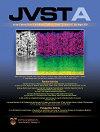高温下纳米多层AlCrN/AlTiSiN涂层的摩擦学行为及磨损机理
IF 2.1
3区 材料科学
Q3 MATERIALS SCIENCE, COATINGS & FILMS
引用次数: 0
摘要
耐磨性能是高速切削刀具涂层的一项关键性能,它取决于涂层的机械性能和抗氧化性能。大量的研究表明AlTiSiN涂层具有良好的力学性能。此外,AlCrN涂层具有优异的抗氧化性能。多层结构可以提高涂层的综合性能。因此,AlCrN/AlTiSiN多层涂层在机械加工领域具有很大的应用潜力。研究了AlCrN/AlTiSiN多层涂层的高温摩擦学性能。结果表明,AlCrN/AlTiSiN涂层具有良好的耐磨性,耐磨性可达800℃。同时,在800℃时,AlCrN/AlTiSiN涂层的摩擦系数最低,为~ 0.5,磨损率为1.8 × 10 - 6 mm3/N m,分别比AlCrN和AlTiSiN涂层低58.13%和64.0%。高温磨损轨迹的成像和成分分析可以解释磨损机制的差异。在800℃时,AlCrN/AlTiSiN涂层表面形成致密的薄摩擦膜,起到釉层的作用,防止磨损。它结合了一层高抗氧化性和另一层高硬度的优点,为提高单层涂层在高温下的耐磨性提供了一种策略。本文章由计算机程序翻译,如有差异,请以英文原文为准。
Tribological behavior and wear mechanism of nanomultilayer AlCrN/AlTiSiN coatings at elevated temperatures
Wear resistance is a critical property of tool coatings for high-speed machining, which depends on mechanical properties and oxidation resistance of the coatings. Many works have demonstrated that AlTiSiN coating has good mechanical properties. Additionally, AlCrN coating exhibits excellent oxidation resistance. The multilayered structure has proved to improve comprehensive properties of the coatings. Therefore, AlCrN/AlTiSiN multilayer coating has a high potential to be used in machining applications. This paper focuses on the high-temperature tribological behavior of AlCrN/AlTiSiN multilayer coating. The results show that AlCrN/AlTiSiN coating exhibits good to acceptable wear resistance up to 800 °C. Meanwhile, AlCrN/AlTiSiN coating also displays the lowest friction coefficient of ∼0.5 and a wear rate of 1.8 × 10−6 mm3/N m at 800 °C, which is about 58.13% and 64.0% lower than that of AlCrN and AlTiSiN coatings, respectively. The imaging and composition analysis of the high-temperature wear tracks allowed for explaining the differences in wear mechanisms. At 800 °C, a dense thin tribofilm is formed on the surface of AlCrN/AlTiSiN coating, which acts as a glaze layer to impede wear. It provides a strategy for enhancing the wear resistance of monolayer coating in high temperatures, which combines the advantages of both high oxidation resistance of one layer and high hardness of the other layer.
求助全文
通过发布文献求助,成功后即可免费获取论文全文。
去求助
来源期刊

Journal of Vacuum Science & Technology A
工程技术-材料科学:膜
CiteScore
5.10
自引率
10.30%
发文量
247
审稿时长
2.1 months
期刊介绍:
Journal of Vacuum Science & Technology A publishes reports of original research, letters, and review articles that focus on fundamental scientific understanding of interfaces, surfaces, plasmas and thin films and on using this understanding to advance the state-of-the-art in various technological applications.
 求助内容:
求助内容: 应助结果提醒方式:
应助结果提醒方式:


